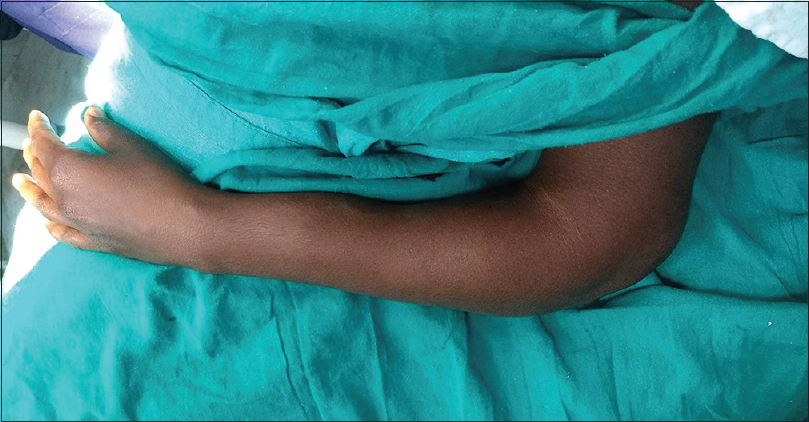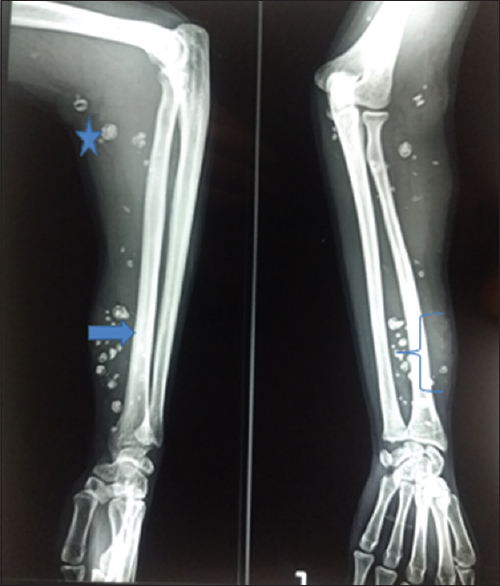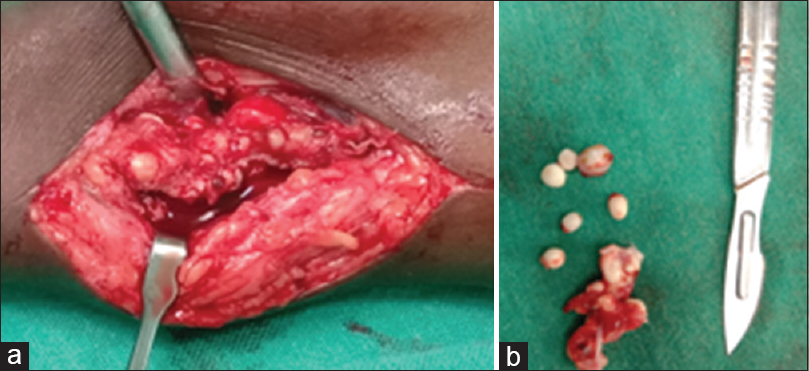Translate this page into:
Intramuscular hemangioma of the forearm and phlebolith – A review of literature with case report
Address for correspondence: Dr. Vivek Kumar, Department of Orthopaedics, GMC, Bhopal, Madhya Pradesh, India. E-mail: vivekkrbhu@gmail.com
-
Received: ,
Accepted: ,
This article was originally published by Wolters Kluwer - Medknow and was migrated to Scientific Scholar after the change of Publisher.
How to cite this article: Mishra PK, Kumar V. Intramuscular hemangioma of the forearm and phlebolith - A review of literature with case report. J Orthop Spine 2020;8:34-7.
Abstract
Intramuscular hemangioma of the forearm (cavernous subtype) with phlebolith is less common in literature and only available as case report. Treatment protocol of intramuscular hemangioma is not established in literature due to sparsely available cases. Here, we discuss the case report with treatment regimen.
Keywords
Hemangioma
phleboliths
subtypes
Introduction
The most common site of intramuscular hemangioma is thigh (36%) followed by calf (17%) muscles.[1] Involvement of the forearm is very less common and only limited as case report.[2] Intramuscular hemangioma of cavernous subtype (with venous stone) is rare in the literature and sparsely available in the literature.[3,4] Hence, here we discuss the intramuscular hemangioma of the forearm with phlebolith and its management as case report.
Case Report
A 32-year-old female patient visited our outpatient department with multiple swelling over the left forearm. On history taking, she revealed that the swelling was noticed about 5 years back. Since then, the number as well as size of the swelling has increased. Since that time off and on, the mild pain is present. Now, there are substantial discomfort and vague pain.
On inspection, there was multiple swelling over the flexor and extensor aspect of the forearm and posterior aspect of the distal arm [Figure 1]. The swelling had a smooth surface and indistinct margin. On palpation, it was firm in consistency, arising from muscles, tender on deep palpation, and without a local rise of temperature. There was no preceding history of injury, weight loss, fever, night cries, and similar swelling in family or other body parts. X-ray (anteroposterior and lateral) of the part revealed the multiple subcutaneous and intramuscular swelling with multiple calcified areas [Figure 2]. Clinico-radiological diagnosis of calcified hydatid cyst and dystrophic calcification was installed, and further planned for magnetic resonance imaging (MRI).

- Left forearm and elbow showing multiple diffuse swelling

- X-ray of the forearm with elbow and wrist with intramuscular swelling (bracket) and calcified thrombus as phlebolith (star) and cortical thickening (arrow)
T1-weighted coronal section of the forearm (a) showed the increased signal intensity of fat content and the areaof low signal intensity due to fibrous tissue or calcified thrombi or phlebolith in flexor group of muscles. T2-weighted axial images showed increased signal intensity in “bag of worm” or tubular appearance [Figure 3]. Now, provisional diagnosis of hemangioma with phlebolith was installed. The patient was explained about the pathology, and conservative management was scheduled in the form of painkillers and physiotherapy. However, even after 3 months of regimen, there was no improvement. Finally, all the feasible therapies at our center were discussed with her. Although the MRI had almost clinched the diagnosis, for surety, histopathological examination was needed.

- T1-weighted coronal section (a) shows the increased signal intensity due to fat content and area with low signal intensity is due to fibrous tissue or calcified thrombi or phlebolith. T2-weighted axial images (b) shows increased signal intensity in “bag of worm” or tubular appearance
Since it was not feasible to remove all the lesion, so the excisional biopsy from the most painful area of lesion was done and sent for the histopathological examination. Intraoperatively, it appeared as hemangioma and there was a gush of bleeding, the feeding vessels were ligated and the multiple phleboliths were found. Histopathology confirmed the diagnosis of cavernous subtype of hemangioma with phleboliths [Figure 4]. After wound healing, the patient referred for radiotherapy and 2000 cGy radiation given in 10 fractions. After 1 year of follow-up, the swelling has reduced and pain has disappeared. The patient is happy and has returned to her work.

- Intraoperative image (a) showing hemangioma and (b) dissected out phleboliths
Discussion
Hemangioma is vascular malformation arising from endothelial tissue and comprises up to 10% of childhood soft-tissue tumor and congenital in nature.[5] Liston firstly reported the case of intramuscular cavernous hemangioma and called as “erectile tumor.” Intramuscular hemangiomas are supposed to be hamartomatous in origin and believed to originate from abnormal embryonic rests.[6] Boye et al. proposed the hypothesis that the primary defect is intrinsic to endothelial cells, instead of other cell types which constitutes the hemangioma.[7] Intramuscular hemangioma is only 1% of all hemangiomas. Long time after the birth, the hemangioma becomes obvious and recognizable and sometimes there is a surge of growth in the second to third decades of life.[8]
Superficially located hemangiomas give the blue tinge to the skin, while the deeper one presents as tender mass. In general clinical settings, the intramuscular hemangiomas are not conceded as a differential diagnosis of musculoskeletal pain. Long-standing discomfort (rather than pain) with a new appearing lesion (mass) is a typical presenting feature of intramuscular hemangiomas.[9,10] Our patient had chronic mild off-and-on pain in the left forearm for 5 years, with new appearing swelling. Since in our case, the skin complexion of the patient was dark, so the skin color change was not obvious.
Phleboliths, also known as venous stone, are due to multiple calcifications of the thrombus in hemangiomas. There is only limited availability of case report for the association of phleboliths with intramuscular hemangioma.[11] Maki et al. proposed the histological classification of hemangioma as a capillary, cavernous, venous, arteriovenous, and mixed type and which is mostly adopted nowadays.[12] Cavernous subtype of hemangioma is less common than capillary subtype.
Conventional radiological features of hemangiomas are not always informative. Cortical thickening, soft-tissue mass, and phleboliths are findings in few cases.[13] MRI is the noninvasive investigation of choice for hemangioma. It well differentiates between hemangioma and malignancy, even without biopsy. T1-weighted images of MRI show the increased signal intensity of fat content and area with low signal intensity are due to fibrous tissue or calcified thrombi (phlebolith). T2-weighted images show the increased signal intensity in “bag of worm” or tubular appearance in comparison to surrounding muscles.[14] Moreover, if the diagnosis is still in doubt, then the close or open biopsy can be done.[10]
First-line offered treatment for isolated intramuscular hemangioma is by conservative mean. Bella et al. in their study found that up to 76% of cases of minimally bothering intramuscular hemangioma had been managed conservatively. Regression of intramuscular hemangiomas has not been mentioned in literature. Hence, often, the therapy is needed if there is a concern of rapid growth, intractable pain, esthetic issue, or function deficit. Surgical intervention is preferably suited for solitary, well-circumscribed, and less infiltrative intramuscular hemangioma. Hence, the wide local excision is recommended due to feeding vessels. Inadequate excision has resulted in the recurrence in 18%–61% of cases in the literature.[15]
Corticosteroid (oral and local infiltration) and radiotherapy also have been used primarily for systemic intramuscular hemangioma.[16] Systemic corticosteroid (prednisolone) is primarily used, but mechanism of action of steroids is not obvious. It is presumed that it shows the inhibitory action on the production of vascular endothelial growth factor A by stem cells in hemangioma.[17] Pulsed dye laser (PDL) is also used for treating the ulcerated hemangioma. It subsides the pain and enhances healing as well as clears the residual telangiectasia.[18] There are other nonrandomized trials, those claim that PDL is a favorable option than the wait-and-watch policy.[19] Qiu et al. suggested that the imiquimod can be used as an another treatment option of hemangiomas. Imiquimod acts as an immunomodulator with antiangiogenic and proapoptotic action. Imiquimod is used as (5%) cream, which can be washed the next morning. However, the severe inflammatory reactions are the drawback.[20] Embolization has been used to treat the tumor by few authors.[21] Furthermore, the multiple intralesional sclerotherapy is also in practice for suitable case.[22]
Our case persistently had the substantial pain, even after the prolong schedule of conservative approach. We were not in favor to go for corticosteroid therapy, and embolization was not feasible at our center. Furthermore, due to the multiple involvement of the site of the forearm with arm, it was not feasible to operate each lesion, so we surgically removed the most painful areas and for the rest of the lesion, the radiotherapy was given.
Conclusion
The general consensus for the management of intramuscular hemangioma is not established. It can be individualized as per the case. In our case, surgical interventions and radiotherapy have shown the favorable outcome, so it can be used as a combined modality of treatment.
Declaration of patient consent
The authors certify that they have obtained all appropriate patient consent forms. In the form the patient(s) has/have given his/her/their consent for his/her/their images and other clinical information to be reported in the journal. The patients understand that their names and initials will not be published and due efforts will be made to conceal their identity, but anonymity cannot be guaranteed.
Financial support and sponsorship
Nil.
Conflicts of interest
There are no conflicts of interest.
References
- Surgical treatment of hemangiomas of soft tissue. Clin Orthop Relat Res.. 2002;399:205-210.
- [CrossRef] [PubMed] [Google Scholar]
- Intramuscular hemangioma of the forearm: Seven cases. Ann Chir Plast Esthet. 2013;58:243-7.
- [CrossRef] [PubMed] [Google Scholar]
- Cavernous hemangioma of the left forearm. Rare Tumors. 2015;7:5895.
- [CrossRef] [PubMed] [Google Scholar]
- Cavernous hemangioma of the buccinator muscle-MRI features. Pac J Med Sci. 2013;12:65-70.
- [Google Scholar]
- Clonality and altered behavior of endothelial cells from hemangiomas. J Clin Invest. 2001;107:745-52.
- [CrossRef] [PubMed] [Google Scholar]
- Intramuscular hemangioma of the head and neck. Otolaryngol Head Neck Surg. 1993;108:18-26.
- [CrossRef] [PubMed] [Google Scholar]
- Hemangioma of skeletal muscle. Arch Orthop Trauma Surg. 2000;120:139-43.
- [CrossRef] [PubMed] [Google Scholar]
- Adult onset flatfoot associated with an intramuscular hemangioma of the posterior tibialis muscle. Orthopedics. 2008;31:280.
- [CrossRef] [PubMed] [Google Scholar]
- Intramuscular hemangioma with phleboliths of the tongue. Indian J Dent. 2014;5:100-1.
- [CrossRef] [PubMed] [Google Scholar]
- Radiologic case study. Intramuscular hemangioma. Orthopedics. 1996;19(916):907-9.
- [CrossRef] [PubMed] [Google Scholar]
- Imaging strategies in the evaluation of soft-tissue hemangiomas of the extremities: Correlation of the findings of plain radiography, angiography, CT, MRI, and ultrasonography in 12 histologically proven cases. Skeletal Radiol. 1992;21:11-8.
- [CrossRef] [PubMed] [Google Scholar]
- Radiologic appearance of intramuscular hemangioma with emphasis on MR imaging. AJR Am J Roentgenol. 1990;154:563-7.
- [CrossRef] [PubMed] [Google Scholar]
- Intramuscular hemangioma: Recurrence risk related to surgical margins. Clin Orthop Relat Res. 2007;459:186-91.
- [CrossRef] [PubMed] [Google Scholar]
- The problem of intramuscular haemangioma. Arch Orthop Trauma Surg. 1982;100:243-7.
- [CrossRef] [PubMed] [Google Scholar]
- Multipotential stem cells recapitulate human infantile hemangioma in immunodeficient mice. J Clin Invest. 2008;118:2592-9.
- [CrossRef] [PubMed] [Google Scholar]
- Efficacy of pulse dye laser therapy for the treatment of ulcerated haemangiomas: A review of 78 patients. Br J Plast Surg. 2003;56:317-27.
- [CrossRef] [PubMed] [Google Scholar]
- Outcomes of childhood hemangiomas treated with the pulsed-dye laser with dynamic cooling: A retrospective chart analysis. Dermatol Surg. 2009;35:1947-54.
- [CrossRef] [PubMed] [Google Scholar]
- Imiquimod 5% cream versus timolol 0.5% ophthalmic solution for treating superficial proliferating infantile haemangiomas: A retrospective study. Clin Exp Dermatol. 2013;38:845-50.
- [CrossRef] [PubMed] [Google Scholar]
- Misdiagnosis of pathological femoral fracture in a patient with intramuscular hemangioma: A case report. Oncol Lett. 2016;12:195-8.
- [CrossRef] [PubMed] [Google Scholar]
- Two different treatment options for intramuscular plantar hemangioma: Surgery versus percutaneous sclerotherapy. J Foot Ankle Surg. 2014;53:759-62.
- [CrossRef] [PubMed] [Google Scholar]






